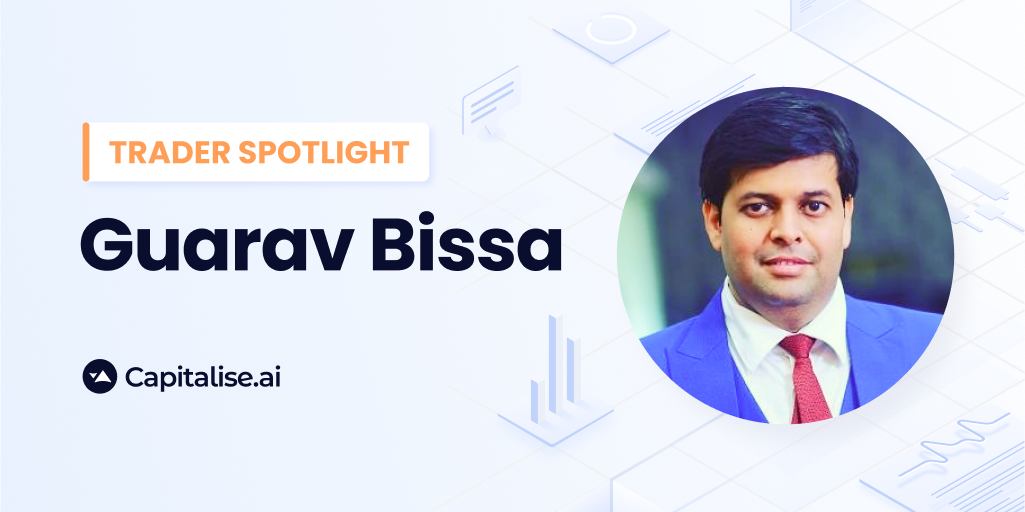Guarav started his career at the peak of the financial crisis of 2008 – despite a tough beginning, this helped make him the flexible and versatile trader that he is today.
In his career spanning over a decade, he has set up research desks and worked with market participants across a wide variety of industries (everything from Retail to Insurance), and is a regular guest on various business and market discussion channels.
We were glad for the opportunity to interview him!
First thing’s first (we always ask this) – What’s the worst mistake you ever made trading stocks?
My early in the market was actually very successful. We call this beginners luck.
I discovered stock trading during my college days and it immediately garnered lot of interest from me. I started delivery trading in largecap stocks with small amounts, and gradually began putting in quite a lot of money in Midcaps and Smallcaps.
As you can imagine, the debacle of 2008 resulted in quite a loss for me, as I was very confident by then even though I had not developed any system for initiating a trade. This is one mistake which cost me a lot but also taught me a very valuable lesson.
There should ALWAYS be a compelling reason to take a trade, and there should always be a plan before one takes a trade. Naturally not everything will go according to plan, but at-least one can create some form of measures to mitigate risk.
What are the key variables you look for when analyzing the market? Do you tend to favor Fundamental Analysis, Technical Analysis or a homemade mix of the two? Quant? Voodoo magic?
I strictly follow Technical Analysis. While I respect every form of research, I’m of a firm belief that one should not just understand things superficially, but also learn the intricacies of a craft. Only then can one create their own system and effectively filter out trades.
One of the main methods I follow is similar to the Top Down approach used in Fundamental Analysis – I first analyse benchmark indices, then check which sectors are strong or weak. Then, I check within those sectors which are the strongest and weakest stock. I use this filtered list to create Buy or Sell trades.
What’s been your most successful trade so far? Walk us through it.
One of the most powerful methods of analysis I use is the reversal technique known as Harmonic Patterns. With it, I was able to identify reversals in sectors like Metals and Pharma Indexe very early.
However, I don’t like thinking in terms of ‘most successful’ or ‘least successful’ trade.
Trading is like a train journey. Every station crossed takes you one step closer to your destination. Some stops are fun but some can be bad – it’s what makes the journey memorable!
How do you devise your top performing trading strategies? We’d love it if you could walk us through the logic behind your approach – help our audience level up!
One of the strategies I use is Multiple Frame Analysis, along with 2-3 indicators to identify high probability setups.
In this strategy, I scan good quality stocks which have a retracement anywhere between 88.6% – 100% from major support on weekly or monthly charts.
I then check for RSI as well as MACD divergence on the daily chart.
Once I identify any stock which exhibits these parameters, I wait for a price breakout with a strong volume for entry. This usually results in a very strong upside with very lucrative risk:reward ratios.
This usually results in a very strong upside with very lucrative risk rewards!
What do you do to deal with the stressful nature of trading? How do you keep emotions out of it?
I spend a lot of time in creating a study or system. Once I’m confident, I stick to the plan I’ve created and the system I’ve built, and let it dictate when and how I make trades.
Also, I have devised a reobust and dynamic risk management system which helps me when things don’t go my way. This way I can keep my emotions out of the decision making.
As far as stress is concerned, my kids take care of that. I am blessed to have a wonderful family which absorbs all of my stress. Besides that I like listening to music at intervals – which keeps me light and fresh.
Last but not least, give us parting words of wisdom: What are some things you wish you would have known when you started trading?
The most important thing is to have a trade plan and to stick to it. It needs to be ready before one takes a trade.
Thanks again for joining us for this interview!
Readers: if you’re interested in more of Guarav’s valuable insights, we highly recommend checking out his feed @BissaGuaravB – it’s full of ton point market analysis!
